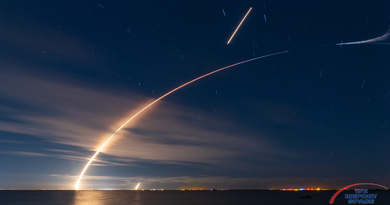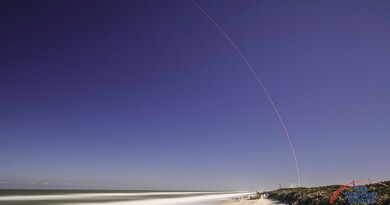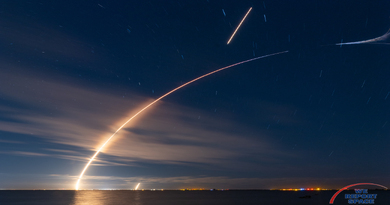OA-5 to Debut Upgraded Antares
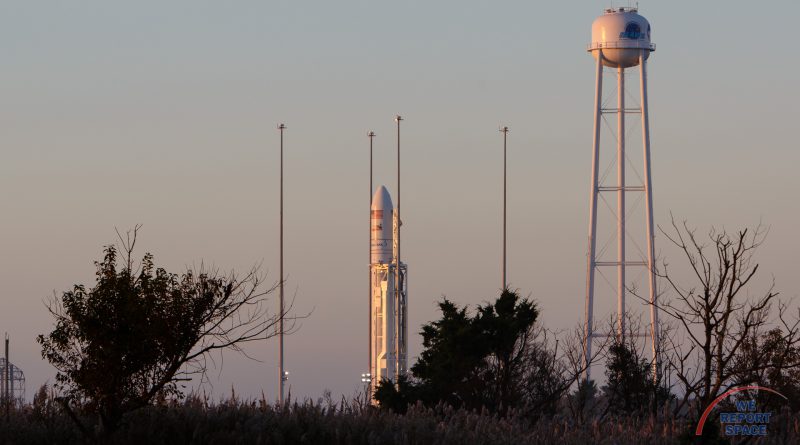
Update: Antares OA-5 has had a 24-hour scrub due to ground support equipment. New launch window is Monday, October 17 between 7:40 - 7:45pm EDT.
Orbital ATK's OA-5 mission, currently scheduled to launch between 8:03 - 8:08pm on Sunday, October 16, will be that company's first flight of the upgraded Antares launch vehicle. Dubbed "Antares 230," this rocket uses a pair of NPO Energomash RD-181 main engines to power its first stage, and a Castor 30XL solid rocket booster as its second stage, putting the Cygnus spacecraft into an orbit to rendezvous with the International Space Station (ISS).
The road to OA-5
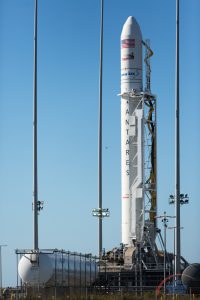
The last flight of Antares, Orbital Sciences Corporation's ORB-3 mission to the ISS, ended in failure just seconds into the launch, due to an anomaly with the Aerojet Rocketdyne AJ-26 engines previously used on the rocket.
Following the ORB-3 explosion, Virginia Commercial Space Authority, in conjunction with both Orbital ATK and NASA, undertook an 11 month, fifteen million dollar effort to rebuild and upgrade launchpad 0A at the Mid-Atlantic Regional Spaceport, the cost being shared among those three partners.
Prior to launch, NASA's Wallops Flight Facility hosted a pre-launch briefing with representatives from Johnson Space Center, Orbital ATK, Wallops Flight Facility and Virginia Commonwealth Space Authority, to present an overview of the upgraded Antares and to address concerns about the maiden flight of this new rocket.
Testing the Antares 230
Earlier this year, Orbital ATK conduced two critical tests of the upgraded Antares on the launchpad, the first being a "wet dress rehearsal," where the rocket is fueled and the launch team proceeds through the entire countdown, stopping short of actually firing the engines. The second test was a "hot fire" test, which adds igniting the RD-181 engines to the previous test. Since late 2015, Orbital ATK has had two Antares rockets in their hangar at the Mid-Atlantic Regional Spaceport, and performed the hot fire test using the rocket booster scheduled to launch the OA-7 mission later this year / early next year.
Given the success of those two tests, along with tests which are performed on individual components such as the RD-181 engines themselves, Orbital ATK is confident in moving forward with the launch of the Antares 230 rocket and Cygnus spacecraft, using this mission to the ISS as the maiden flight of the launch vehicle. Mike Pinkston, Antares program vice president and general manager, stated during Saturday's briefing that the tests, plus the increased instrumentation on the Antares rocket give them the confidence to undertake this launch.
Watching the Launch
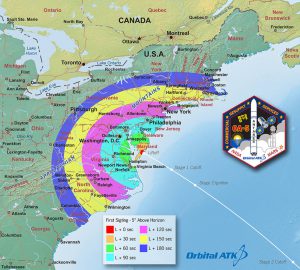
Tonight's launch from Virginia should be visible from New Hampshire all the way to South Carolina, with the rocket lifting off no earlier than 8:03pm and following a southeastern trajectory.
The Antares 230 launch vehicle has a five-minute window to launch to the ISS this week, so launch can take place as late as 8:08pm, though according to Orbital ATK's Frank Culbertson, the Antares launch team does not have the ability to "rewind the clock," in the event of a hold during the terminal countdown, and Mike Pinkston indicated that while they do have the full five minutes to launch, it would be unusual that a 1-2 minute hold would save the day but it isn't out of the question, and they use the five minute window to work around any issues.
Dale Nash, from Virginia Space, added that part of the rebuilding effort on launchpad 0A provides the opportunity to perform 24 hour recycles day after day (after day), and that "the people would time out before the launchpad."
If for any reason the rocket launch is canceled on Sunday, backup launch opportunities exist on Monday, Tuesday and Wednesday nights, with each launch opportunity moving approximately 25 minutes earlier each night.
For those outside the east coast, NASA TV will be streaming the launch live on their website, and We Report Space will be providing coverage via our website, Facebook and Instagram accounts.


Stunning, full color photo book covering every east coast launch spanning 2014-2015, including the first-ever powered landing of a SpaceX Falcon 9 rocket.
More Info

